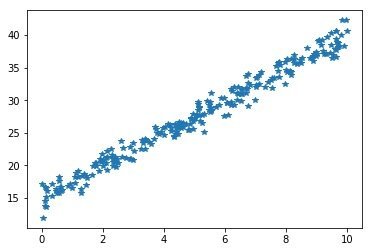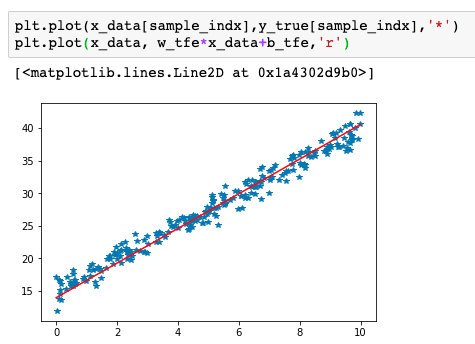Tensorflow入门——Eager模式像原生Python一样简洁优雅
image source from unsplash.com by Sergio souza
众所周知,Tensorflow入门之所以困难,与其采用的Graph 和 Session 模式有关,这与原生的 Python 代码简单、直观的印象格格不入。同时,由于计算仅仅发生在Session里面,所以初始化参数和变量的时候没办法将结果打印出来,以至于调试起来也十分困难。
当然Google官方也意识到了这点,于是引入了Eager模式,在这个模式下tensorflow的常量和变量可以直接计算并打印出来,甚至还可以和numpy数组混合计算。本文代码参考官方教程(from github with Apache License 2.0)
同样的,为了方便与读者交流,所有的代码都放在了这里:
https://github.com/zht007/tensorflow-practice
1. 激活Eager模式
激活Eager模式也非常简单,仅几行代码。
import tensorflow as tf
tf.enable_eager_execution()
tfe = tf.contrib.eager
注意,eager模式在程序开始就要激活,且不能与普通模式混用。另外tfe在后面优化器(Optimizer)的时候需要用到,故先在这里定义了。
2. Eger模式上手
Eger模式下,定义的变量或者常量可以直接打印出来
a = tf.constant([[1, 2],
[3, 4]])
print('a=',a)
b = tf.Variable(np.zeros((2,2)))
print('\n b=',b)
c = tf.Variable([[6, 7],
[8, 9]])
print('\n c=',c)
-------output-------
a= tf.Tensor(
[[1 2]
[3 4]], shape=(2, 2), dtype=int32)
b= <tf.Variable 'Variable:0' shape=(2, 2) dtype=float64, numpy=
array([[0., 0.],
[0., 0.]])>
c= <tf.Variable 'Variable:0' shape=(2, 2) dtype=int32, numpy=
array([[6, 7],
[8, 9]], dtype=int32)>
可以直接转换成我们熟悉的numpy arrary
print(c.numpy())
---output---
[[6 7]
[8 9]]
当然也可以直接计算并输出结果,甚至可以与numpy arrary 混合计算。
x = tf.Variable([[6, 7],
[8.0, 9.0]],dtype ="float32")
y = np.array([[1,2],
[3,4]],dtype ="float32")
print(tf.matmul(x,y))
----output----
tf.Tensor(
[[27. 40.]
[35. 52.]], shape=(2, 2), dtype=float32)
3. Eager 模式下训练线性回归模型
最后我们用Tensor Flow 在Eager模式下训练线性回归模型,该模型我们之前已经用Tensorflow和Keras训练过了,感兴趣的朋友可以参照之前的文章进行对比。
3.1 创建模拟数据
与之前的数据一样,此处数据是100万个带噪音的线性数据,100万个点用plt是画不出来的,图中随机采样了250个点
我们定义一个帮助函数方便以batch的形式这100万个数据点中随机抽取batch size大小的数据进行训练
def next_batch(x_data, batch_size):
batch_index = np.random.randint(len(x_data),size=(BATCH_SIZE))
x_train = x_data[batch_index]
y_train = y_true[batch_index]
return x_train, y_train
3.2 定义变量
此处与普通模式下的tensorflow变量没有任何区别
w_tfe = tf.Variable(np.random.uniform())
b_tfe = tf.Variable(np.random.uniform(1,10)
3.3 线性函数
在普通模式下的tensorflow中我们需要定义计算图谱,这里我们直接以 python 函数的形式,定义要训练的线性回归函数。
def linear_regression(inputs):
return inputs * w_tfe + b_tfe
3.4 损失函数
同样的,MS(Mean Square)损失函数也要以python 函数的形式定义,而不是计算图谱。
def mean_square_fn(model_fn, inputs, labels):
return tf.reduce_sum(tf.pow(model_fn(inputs) - labels, 2)) / (2 * BATCH_SIZE)
3.5 优化器
同样使用Gradient Descent 的优化器,不同在于,普通模式下我们创建一个计算图谱train = optimizer.minimize(error), 在Eager模式下,要用tfe.implicit_gradients()来返回一个函数。
optimizer = tf.train.GradientDescentOptimizer(learning_rate=0.001)
grad = tfe.implicit_gradients(mean_square_fn)
3.6 模型训练
由于没有计算图谱,所以也不需要初始化变量,也不需在Session下运行,而是类似于原生 Python 函数的形式将数据传入"Optimizer模型"函数。训练完成之后,w 和 b 的参数也自动保存下来,不必在Session中提取。
for step in range(BATCHS):
x_train, y_train = next_batch(x_data, BATCH_SIZE)
optimizer.apply_gradients(grad(linear_regression, x_train, y_train))
3.7 验证训练结果
直接将最终的 w 和 b 带入线性函数,训练结果也非常符合预期。
4. 总结
Eager 模式下的 Tensorflow 与原生的 Python 代码非常类似,可以直接计算并打印结果,创建和训练模型的过程也类似于python函数的创建和调用。Eager 和Keras API 都是Tensorflow 2.0 官方主推的 Tensorflow使用方式,相信在不久的将来,获取我们就再也看不到 init = tf.global_variables_initializer() 还有 with tf.Session() as sess:这样的类似八股文一样的关键词啦。
参考资料
[2] Github TensorFlow-Examples
相关文章



你那里天气如何?想一展歌喉吗?好声音@cn-voice欢迎你~假如我的留言打扰到你,请回复“取消”。
This post has been voted on by the SteemSTEM curation team and voting trail. It is elligible for support from @curie.
If you appreciate the work we are doing, then consider supporting our witness stem.witness. Additional witness support to the curie witness would be appreciated as well.
For additional information please join us on the SteemSTEM discord and to get to know the rest of the community!
Please consider setting @steemstem as a beneficiary to your post to get a stronger support.
Please consider using the steemstem.io app to get a stronger support.
Congratulations @hongtao! You have completed the following achievement on the Steem blockchain and have been rewarded with new badge(s) :
You can view your badges on your Steem Board and compare to others on the Steem Ranking
If you no longer want to receive notifications, reply to this comment with the word
STOPDo not miss the last post from @steemitboard: